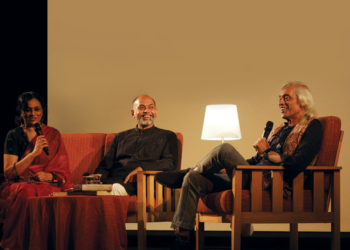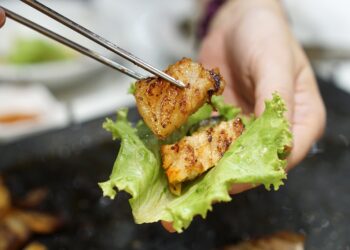Raan Musallam, marinated, steamed and cooked, is one of the delicacies to emerge from the court of epicurean Nawab Wajid Ali Shah, and it continues to be the gastronome’s delight 150 years later
BY ANAND MANIKUTTY & AMITA ROY
Raan means leg o’ mutton and musallam (Persian) means steam while Dum is cooking an entire leg o’ mutton marinated in fragrant spices and
steamed covered for hours. It was Nawab Wajid Ali Shah who introduced the dum pukht style of cooking to Lucknow while building the Bara Imambara. Cooks were hired by him to feed hundreds of labourers and these cooks introduced the method of slow steam cooking to feed them hot food at night. The marinated leg o’ mutton cooked with steam became a favourite which was further refined by the descendants of the cooks for generations. Awadhi cuisine reached its zenith under the exiled Nawab Wajid Ali Shah. But its point of origin lies in the Mughal empire which reached the peak of its power around the turn of the 17th century. Royal cuisine had been elevated to the level of being a state concern, as indicated by Abu’l Fazl, the famous court historian of Emperor Akbar in the royal gazette Ain–e–Akbari. In reality, it was the Mughals who first gave shape to the concept of Indian cuisine though they never truly made it pan-Indian. Feudalistic in nature, rich and costly ingredients made
Mughal cuisine primarily haute cuisine, though pared down versions gradually came to be adopted by the commoners in north India. It retained its very central Asian character of adding dry fruits.
A regional variant developed in the suba of Awadh, incorporating local peasant cooking in the capital, Lucknow. Awadhi cuisine to this day remains a symbol of aristocratic, sophisticated traditions of Islamic cooking marked by subtle use of aromatic spices and the dum pukht technique, the slow cooking of meat and rice in a round pot or handi with the lid sealed with dough. The Nawabs of Awadh belonged to a dynasty of Persian origin from Nishapur, Iran. The Raan-e-Musallam available at the legendary Bukhara restaurant at ITC Maurya in New Delhi was curated by another legend, MasterChef Imtiyaz Qureshi whose ancestors were royal Khansamas in the kitchens of the Nawab of Awadh. Raan-e-Musallam has local variants, like those from Jaunpur and Rampur, but the one from Awadh is probably most popular.
RECIPE
INGREDIENTS
1.2 kg full-meat raan; 125 gm clarified butter; 80 ml curd; 2 tbsp ginger-garlic paste; 2 tbsp kewda water; 2 tbsp salt; 5 qts onion (cut and fried); 3 tbsp papaya paste; 1.5 tbsp Kashmiri chilli powder (used only for colour); 10 qts cashew paste; 10 qts almond paste; 1/2 tbsp cardamom powder; 1/2 tbsp black pepper; 1/2 tbsp hot spices powder; 1.5 tbsp coriander powder; 2 tbsp red chilli powder.
METHOD
TO MARINATE THE RAAN
Step 1: Pour the curd in a medium-sized bowl.
Step 2: Add the ginger-garlic paste, kewda water, salt,
cashew-almond paste, papaya paste, Kashmiri chilli powder
and fried onion paste (chopped onions fried in clarified
butter until golden, cooled and blended to a smooth paste).
Step 3: Add the spice powders – cardamom powder, black
pepper powder, hot spices powder, coriander powder and
red chilli powder.
Step 4: Mix all the ingredients well.
Step 5: Place the raan in a large dish/tray. Score the raan
(make four deep slashes on each side).
Step 6: Fill the spice mixture well into the scored areas and
coat it all over. Flip the raan and apply the spice mixture
similarly on the other side.
Step 7: Cover and marinate for two hours.
COOKING PROCESS
Step 8: Heat a pot over medium-high heat. Pour the clarified
butter and wait for a minute until it heats up.
Step 9: Gently place the marinated raan (along with all the
spices) in the pot. Cover and cook for 30 minutes on
medium-low heat. At the 15-minute mark, flip the raan and
cover again.
Step 10: After the 30 minutes are up, remove the lid and
baste the meat for one to two minutes with the juices
released by the meat.
Step 11: Pour in about a cup of water. Cover and cook for 30
minutes on medium-high heat. Remember to flip the raan
at the 15-minute mark.
Step 12: Uncover and baste the meat for a minute. Then
cover and cook for 15 to 20 minutes more.








